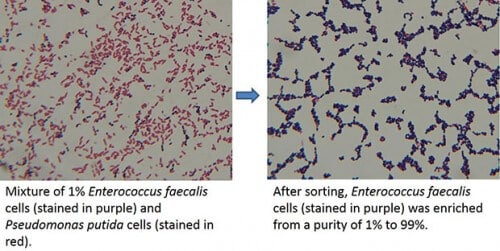The new method developed at the University of Hawaii relies on a measurement principle that sorts cells by characterizing their unique free surface energies

[by Dr. Nachmani Moshe]
A new and extremely efficient method for cell sorting capable of separating 10 billion bacterial cells in just 30 minutes has long been developed.
The innovative method has already been proven to be useful for examining bacterial cells and microalgae, and in the future can pave the way for direct applications in the fields of biomedical research and environmental sciences - and in fact, in any scientific field where it is necessary to process a huge amount of bacterial samples. The researchers were able to develop an innovative and efficient method capable of sorting cells while separating 10 billion bacterial cells within 30 minutes. The new method was described in an article published in the scientific journal Analytical Chemistry.
Almost all existing methods for cell sorting rely on the principle known as single-cell analysis. These methods sort cells with the help of running each of the cells separately through a selective passage that captures within it cells with a defined and unique physical property; For example, such methods are designed to sort cells based on their size or to locate cells with a unique characteristic, such as cells attached to a fluorescent dye. The new method is completely different - it is a volumetric method that sorts different populations of cells by adjusting their solubility. "Our new method does not have any visible limitations in sorting large amounts of cells," notes the lead researcher. "We are able to sort 10 billion bacterial cells within 30 seconds."
The new method relies on a measurement principle that sorts cells by characterizing their unique free surface energies. For the surface of liquids, the surface free energy is equal to the surface tension, but for the surface of a solid, as in the case of cells, the surface free energy is not directly measurable. Instead, the surface free energy for solids was previously estimated from contact angle measurements using complex theoretical calculations.
"Despite being plausible, the application of this principle was particularly challenging," explains the lead researcher. "Compared to all other cell properties, such as size and deformability, measuring this property (the free surface energy) is a major technical challenge. Only recently have we been able to develop an innovative spectrophotometric method for direct measurement of the surface free energy of living cells. Based on this technological advance, we are able to apply the principle of sorting cells according to the free surface energy of the cells."
The research group examines the molecular mechanisms of surfactants in the lungs, substances that are essential for maintaining normal respiratory function in the air pockets in the lungs. The researchers hope to expand the use of clinical surfactants to treat a variety of respiratory diseases in newborns and adults, including a disease called respiratory distress syndrome.

One response
There are mistakes in 30 seconds/minutes and it's confusing